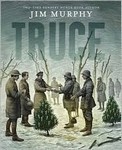Through the Looking Glass Children's Book Reviews
Truce
Nonfiction
For ages 9 to 12
Scholastic, 2009 ISBN: 0545130492
When war broke out on July 29th, 1914, people around the world got very excited. Young men rushed to “join up,” and patriotic fervor swelled. Songs were sung, flags flew, and everyone talked about the war as if it was “a glorious adventure.” Everyone was sure that the war would not last long, that it would be “over by Christmas,” and many young men worried that they might not get their chance to participate.
They needn’t have worried, because the war showed no signs of ending anytime soon. Back and forth the battles raged with little ground being won. Thousands of people died, and the soldiers discovered the true horror of modern warfare. Misery settled in the trenches as it rained incessantly and got colder and colder. Trudging through mud, and plagued by fleas and lice, the soldiers sickened. As they watched their comrades die, many of the soldiers began to realize that the war was a hopeless and senseless one. What were they really fighting for? What were the generals really trying to achieve?
On December 24th, the soldiers were fighting the cold, illness, and despair. Many soldiers on both sides tried to inject a little seasonal cheer into their lives. The Germans put up little Christmas trees, the British collected mistletoe. Christmas carols floated up from the trenches as toasts were drunk, and small precious gifts were opened and shared. Guns were not fired, and into this time of quiet, something remarkable happened.
This is the story of how the spirit of Christmas was still able to prevail during a terrible time in human history. Though the story of this war is painful, the descriptions of how the soldiers of both sides ceased to fight - for a time - is powerful and heartwarming. Readers will come to think, as a journalist of the time did, that Europe would have been “natural and human,” if the soldiers instead of the “diplomats and potentates,” were making the decisions.
Full of first hand accounts, quotes, and period photographs, this is a wonderful example of the nonfiction genre.




